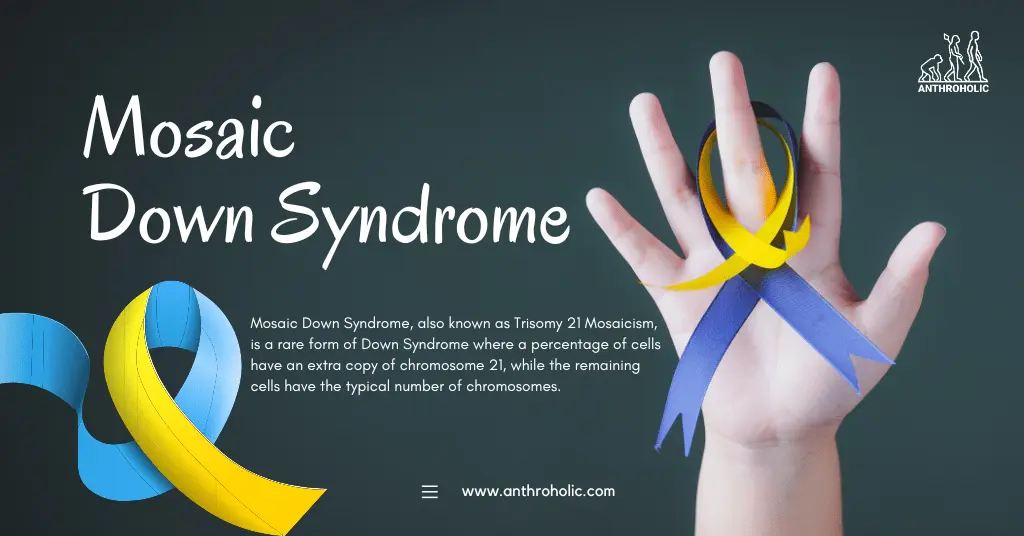AI Answer Evaluation Platform Live Now. Try Free Answer Evaluation Now
Mosaic Down Syndrome
Mosaic Down Syndrome, also known as Trisomy 21 Mosaicism, is a rare form of Down Syndrome where a percentage of cells have an extra copy of chromosome 21, while the remaining cells have the typical number of chromosomes. This is different from the more common form of Down Syndrome, in which all cells contain a third copy of chromosome 21. The term ‘mosaicism’ is derived from the art term ‘mosaic,’ which refers to a picture made up of different pieces. In this genetic context, it indicates that some cells have a different genetic makeup than others.

Genetics Behind Down Syndrome
Explanation of Trisomy 21
Trisomy 21 is the genetic disorder known as Down syndrome. Down syndrome is characterized by the presence of an additional, or third, copy of chromosome 21. The human genome typically contains 23 pairs of chromosomes, for a total of 46. However, individuals with Down syndrome have 47 chromosomes because of the extra copy of chromosome 21.
Chromosome 21 is the smallest human chromosome, containing about 200 to 300 genes, but the exact number is still not definitively known [1]. Although it’s the smallest, the additional genetic material it provides when triplicated disrupts the typical developmental processes, leading to the characteristics associated with Down syndrome. The physical features can include distinctive facial features, heart defects, delayed physical growth, intellectual disability, and other health problems [2].
The extra genetic material from chromosome 21 leads to overexpression of some genes, disrupting normal biological function. This can influence everything from cell division to metabolism to brain development.
The Process of Nondisjunction
Nondisjunction is a failure in the proper separation of chromosomes during meiosis, the type of cell division that produces gametes (eggs and sperm). Each resulting gamete should have one copy of each chromosome, but nondisjunction can cause a gamete to have an extra copy (n+1) or lack a copy (n-1) of a particular chromosome [3].
In the case of Trisomy 21, nondisjunction occurs with chromosome 21. This usually occurs during the formation of the egg, but it can also occur during the formation of the sperm or after fertilization during an early embryonic cell division. When a gamete with an extra chromosome 21 fuses with a normal gamete during fertilization, the resulting zygote will have three copies of chromosome 21 in each cell [4].
When the non-disjunction event occurs after fertilization, it results in a condition called mosaicism. In Mosaic Down syndrome, not all cells have the extra chromosome 21. Some cells have the regular two copies, while others have three. The percentage of cells with Trisomy 21 can vary, and this variation can influence the severity and type of symptoms a person experiences.
Variants of Down Syndrome
- Complete Trisomy 21: Complete Trisomy 21, also known as Standard or Nondisjunction Down Syndrome, is the most common form of Down Syndrome, accounting for about 95% of cases. It results from an error in cell division called non-disjunction, which leaves a sperm or egg cell with an extra copy of chromosome 21. When this cell contributes to the formation of a zygote, it results in every cell of the body having three copies of chromosome 21, instead of the usual two.
- Translocation Down Syndrome: Translocation Down Syndrome is responsible for about 3-4% of Down syndrome cases1. Unlike complete trisomy 21, the total number of chromosomes in the cells remains 46 instead of 47. However, an additional full or partial copy of chromosome 21 attaches or “translocates” to another chromosome, usually chromosome 14. The presence of this extra genetic material from chromosome 21 leads to Down syndrome characteristics.
- Mosaic Down Syndrome: Mosaic Down Syndrome, the least common form, accounts for only about 1-2% of all cases of Down syndrome1. This form results from nondisjunction of chromosome 21 during an early cell division after fertilization. This results in a population of cells with the normal number of chromosomes (46) and a population of cells with an extra copy of chromosome 21 (47). Hence, not all cells have the extra chromosome 21.
Mechanism of Mosaic Down Syndrome
How Mosaicism Occurs
Mosaicism refers to the presence of two or more populations of cells with different genotypes in one individual who has developed from a single fertilized egg. In the case of Mosaic Down Syndrome, this means that some cells have the typical two copies of chromosome 21, while other cells have three copies.
Mosaicism in Down syndrome is thought to occur due to a non-disjunction event that takes place in one of the initial cell divisions after fertilization. If the non-disjunction event happens at this stage, only some of the cells derived from this aberrant division will have an extra chromosome 21. The rest of the cells, derived from divisions that had the correct segregation of chromosomes, will have the typical number.
The proportion of cells with Trisomy 21 in an individual with Mosaic Down syndrome can vary widely. This can influence the severity and type of symptoms a person experiences. Some individuals with a high proportion of normal cells may have milder features of Down syndrome or may go undiagnosed.
The Role of Mitotic Errors
Mitotic errors play a critical role in the development of Mosaic Down syndrome. Mitosis is the process of cell division that generates two daughter cells with the same number of chromosomes as the parent cell.
When a nondisjunction event happens during an early mitotic division after fertilization, it results in an unequal distribution of chromosomes between the daughter cells. One cell receives an extra copy of chromosome 21, and the other receives the normal amount.
As these cells continue to divide and proliferate, they pass on their chromosomal makeup to their daughter cells. Cells that originated from the cell with the normal amount of chromosome 21 will have 46 chromosomes, while those that originated from the cell with the extra chromosome will have 47. This results in a mosaic pattern of cells within the body, some with Trisomy 21 and some without.
Somatic Versus Germ-Line Mosaicism
Somatic Mosaicism
Somatic mosaicism refers to the presence of genetically distinct populations of cells within the tissues of an individual’s body. This typically results from a mutation that occurs during the development of the embryo, affecting only cells that arise from the original mutated cell.
In the context of Mosaic Down Syndrome, somatic mosaicism implies that some of the individual’s body cells have the typical two copies of chromosome 21, while others have three copies. The proportion of cells carrying the extra chromosome can vary greatly from one individual to another, and this can affect the physical and intellectual manifestations of Down syndrome.
Germ-line Mosaicism
Germ-line mosaicism, on the other hand, involves a mixture of genetically different cells within an individual’s germ cells, which are the cells that give rise to eggs or sperm. This means that while the individual’s body (somatic) cells may all have the typical two copies of chromosome 21, some of their germ cells may have an extra copy.
In such cases, the individual does not show signs of Down syndrome, but they have an increased risk of having children with the condition. It’s important to note that germ-line mosaicism is considered quite rare, and the exact rate in Down syndrome is not well defined.
Clinical Presentation of Mosaic Down Syndrome
Physical Symptoms
The physical manifestations of Mosaic Down Syndrome (MDS) can vary widely among individuals due to the percentage of cells that carry the extra chromosome 21. Some individuals with a high percentage of typical cells may show few, if any, physical features commonly associated with Down syndrome.
That being said, some physical symptoms that may be present include a flattened facial profile, an upward slant to the eyes, a small nose, a single deep crease across the center of the palm (simian crease), low muscle tone (hypotonia), and excessive flexibility. There’s also a higher incidence of congenital heart defects, gastrointestinal disorders, and immune system abnormalities in people with MDS, although these often tend to be less severe than in people with complete trisomy 21.
Cognitive Implications
Cognitive development and intellectual disability in individuals with Mosaic Down Syndrome also varies significantly and is often related to the proportion of trisomic cells in the body and brain. The range of intellectual disability in individuals with MDS can be from mild to moderate, and in some cases, the person may have average intelligence.
Like the physical symptoms, the cognitive symptoms of MDS are generally less severe than those seen in complete trisomy 21. Some individuals may have particular strengths in social engagement and verbal abilities. However, many still face challenges in specific areas of cognitive processing, particularly language, memory, and executive functioning. Early intervention, including speech therapy, occupational therapy, and inclusive education, can significantly help children with MDS reach their full cognitive potential.
Diagnosis of Mosaic Down Syndrome
Importance of Genetic Testing
Diagnosing Mosaic Down Syndrome (MDS) can be a bit more complex than diagnosing typical Down Syndrome due to the presence of two types of cells – normal and those with an extra copy of chromosome 21. Because physical symptoms may be milder or even absent in some cases of MDS, genetic testing becomes crucial for an accurate diagnosis.
Genetic testing can provide a definitive diagnosis and also provide information about the percentage of cells that have trisomy 21, which can be important for prognosis and management of the condition.
Common Methods of Diagnosis
- Karyotyping: Karyotyping is a laboratory procedure that involves the visualization of an individual’s chromosomes. In the case of suspected MDS, it can reveal whether some cells have an extra chromosome 21. It’s important to note that the sample for karyotyping can be taken from different tissues (like blood or skin), and the percentage of trisomic cells may differ among tissues.
- Fluorescence In Situ Hybridization (FISH): FISH is a more sophisticated and sensitive technique that uses fluorescent probes to bind to specific sequences of DNA on chromosomes. In the context of MDS, a probe specific for chromosome 21 is used, and cells showing three fluorescent signals instead of the usual two are indicative of trisomy 21.
- DNA Analysis: High-resolution DNA analysis techniques, such as comparative genomic hybridization and whole-genome sequencing, can also be used to diagnose MDS. These methods can accurately detect and quantify mosaicism for trisomy 21, even if it’s present at low levels.
Challenges in Diagnosis
Diagnosing Mosaic Down Syndrome (MDS) is not without challenges, which stem from the inherent nature of the disorder and limitations of current diagnostic technologies.
Milder or Atypical Physical Symptoms
Due to the presence of both normal and trisomic cells, individuals with MDS often exhibit milder or less typical physical features of Down syndrome, which can make clinical diagnosis challenging. In some cases, MDS may be overlooked or misdiagnosed, particularly if the person does not exhibit the common facial features associated with Down syndrome.
- Tissue-Specific Mosaicism: The proportion of cells with trisomy 21 can differ among tissues in the same individual. Therefore, a test conducted on one type of tissue, such as blood, may not accurately reflect the level of mosaicism in another tissue, like the brain. Hence, a diagnosis based on a blood test may not accurately reflect the overall mosaicism level in the body.
- Limitations of Diagnostic Techniques: Current diagnostic techniques also have their limitations. For instance, conventional karyotyping may not detect low levels of mosaicism or mosaicism in specific tissues. Advanced techniques like FISH and DNA analysis can detect lower levels of mosaicism but are more complex, expensive, and not always available in all settings.
Impact on Life Expectancy and Quality of Life
Health Complications Associated with Mosaic Down Syndrome
Individuals with Mosaic Down Syndrome (MDS) may experience a range of health complications, although the severity and presence of these complications can vary greatly depending on the percentage of cells with the extra chromosome 21.
- Heart Defects: Congenital heart defects are common in individuals with MDS, though they tend to be less frequent and severe than in those with full trisomy 21.
- Endocrine Problems: Hypothyroidism and type 1 diabetes may occur in individuals with MDS.
- Hearing and Vision Problems: Hearing loss, vision problems, and cataracts may also be more common in individuals with MDS.
- Increased Susceptibility to Infections: Due to abnormalities in the immune system, individuals with MDS may have an increased risk of respiratory and other infections.
Cognitive Development and Educational Needs
Cognitive development in individuals with MDS can vary significantly. While some individuals may have mild to moderate intellectual disability, others may have normal intelligence or only mild learning difficulties.
- Educational Support: Children with MDS often benefit from early intervention services and specialized educational strategies, including speech and occupational therapy.
- Social Development: Social skills training can also be beneficial, as some individuals with MDS may have difficulty with social interactions.
- Living Independently: Many adults with MDS are able to live independently, attend regular schools, work in mainstream jobs, and lead fulfilling lives. However, the level of independence achieved can vary based on the individual’s cognitive abilities and the level of support provided.
Current Research and Future Directions
- Understanding Mosaicism: One key area of research is improving our understanding of mosaicism itself. Studies are being conducted to understand how and why non-disjunction events occur and what factors might influence these events. Further research in this area could potentially help us develop strategies for preventing or reducing the occurrence of non-disjunction, which could have implications beyond just Mosaic Down Syndrome.
- Variable Phenotypic Expression: Research is also being conducted to understand why the phenotypic expression of Mosaic Down Syndrome is so variable. In other words, why do some individuals with Mosaic Down Syndrome have severe symptoms while others have much milder symptoms? Studies are looking at factors such as the percentage of trisomic cells and their distribution in the body.
- Development of New Diagnostic Techniques: The development of new diagnostic techniques is another area of active research. For instance, non-invasive prenatal testing (NIPT) using cell-free DNA has emerged as a promising tool for the early detection of trisomy 21. Researchers are also exploring ways to improve the detection of mosaicism in different tissues.
- Long-Term Outcomes and Intervention Strategies: Longitudinal studies are examining the long-term outcomes for individuals with Mosaic Down Syndrome, including cognitive development, health outcomes, and quality of life. These studies are important for developing and refining intervention strategies.
FAQs about Mosaic Down Syndrome
References
[1] Hattori M, Fujiyama A, Taylor TD, et al. The DNA sequence of human chromosome 21. Nature. 2000;405(6784):311-319.
[2] Bittles AH, Glasson EJ. Clinical, social, and ethical implications of changing life expectancy in Down syndrome. Developmental Medicine & Child Neurology. 2004;46(4):282-286. https://doi.org/10.1017/s0012162204000441
[3] Nagaoka SI, Hassold TJ, Hunt PA. Human aneuploidy: mechanisms and new insights into an age-old problem. Nature reviews Genetics. 2012;13(7):493-504.
[4] Hassold T, Hunt P. To err (meiotically) is human: the genesis of human aneuploidy. Nature reviews Genetics. 2001;2(4):280-291.




